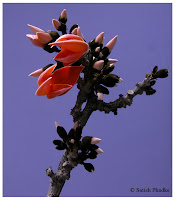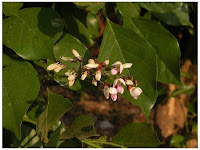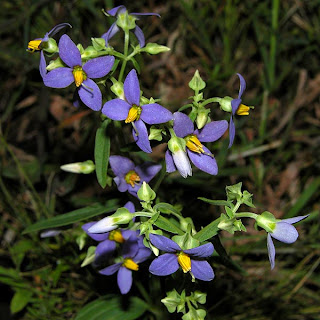
Butea

Erythrina

Dalbergia lanceolaria

Pongamia pinnata

Crotolaria
 Indigofera dalzelli
Indigofera dalzelli
FAMILY OF THE WEEK
PAPILIONACEAE(SUBFAMILY OF FABACEAE/LEGUMINOSAE)
This family is cosmopolitan in distribution but abundant in tropical and subtropical regions. In India 748 species occurring chiefly in peninsular India and the Himalayas.
Vegetative characters:
They are predominantly herbs or herbaceous climbers; sometimes they are erect or climbing shrubs or trees. The climbers have climbing stems but often they climb with leaf tendrils.
The lateral roots of most plants have nodules which contain
nitrogen fixing bacteria(Rhizobium)
The
leaves are usually alternate simple,pinnately or digitately compound.In some genera terminal or other leaflets are modified into tendrils. Stipules are present and often stiplets are present. The leaf base is pulvinous.
The leaves of several genera perform sleep movements where the leaflets assume vertical position at night.
Inflorescence and flowers:The
Inflorescence is commonly axillary, leaf opposed or terminal raceme.Sometimes the flowers are arranged in panicles or dense axillary heads or they are solitary.
The
flowers are often bracteate as well as bracteolate.They are complete,zygomorphic,hermaphrodite,pentamerous and hypogynous or perigynous.The calyx is composed of usually five sepals more or less united in a tube.The odd sepal is usually anterior.
The
corolla is papilionaceous. The five petals are unequal and have a bilateral symmetry.The posterior(outermost) petal is called standard. The lateral pair of petals which are similar to each other and often clawed are called wings. The two anterior petals are united to form the keel which encloses the stamens and carpel.
The
androecium is composed of ten stamens which are arranged in a single whorl in mature flower.The stamens are usually diadelphous. The filaments of nine are united into a long tube which encloses the ovary and the tenth posterior stamen remains free.Anthers are uniform but sometimes they are diamorphous. They are dithecous, introrse and dehisce longitudinally.
The
gynoecium is monocarpellary with a superior or partly inferior unilocular ovary.The ovules are many to several on the ventral suture and the placentation is marginal.The style is simple and the stigma is capitate or terminal.
Fruits and seeds:The fruit is a legume or pod dehiscing by one or both sutures into two valves or it is indehiscent.
Seeds are nonendospermic or with scanty endosperm and with a large curved embryo.
Pollination and dispersal:
Generally pollinated by bees or by self pollination.Nectar is present.
The seeds are usually dispersed by birds,animals or by human agency.
Examples and economic importance:
There is a large list of 100 genera and many species so only few are listed here.
The papilionaceae are of great economic importance and find a wide range of usefulness.
They provide important
foodstuffs,
valuable fodder,
fatty oil,useful
fibre,
timber dyes,
gums and several
beautiful ornamentals.The seeds of several species is rich source of starch and proteins and form an important part of our food.The widely used species include:
Pisum sativum L.(Garden pea)
Pisum arvense L.(Field pea)
Cicer arietinum L.(Chick pea,Gram)Tender seeds and shoots also used as vegetable.
Glycine max syn. Glycine soja(Soyabean)
Cajamus cajan syn. C indicus(Pigeon pea.Arhar)
Lens culinaris syn.
L.aesculanta (Lentil,Masur)
Vigna mungo syn
Phaseolus mungo((Black gram,Urd)
Vigna radiata L. syn
Phaseolus radiatus(Green gram,Mug)
Vigna unguiculata syn
sinensis(Cow pea)
Vigna aconitifolia syn
Phaseolus aconitifolius (Moth)
Phaseolus sublobatus (Gora mung)
Phaseolus vulgaris(Kidney bean,French bean)
Phaseolus lunatus (Lma bean)
Phaseolus coccinius(Multiflora bean)
Dolichos biflorus L.(Horse gram,Kulat)
Lablab purpureus(Hyacinth bean,Sem)
Vicia faba(Field bean,Bankla)
Cyamopsis tetragonoloba syn.
Cyamopsis psoralioides.(Cluster beans,Gawar)Seeds are source of Guar gum
Canavalia ensiformis DC (Jack bean)
Arachis hypogaea L. (Ground nut)
Pongamia pinnata syn.
Pongamia labra(Pongam oil tree,Karanj)
Psophocarpus tetragonolobus DC (Goa bean)oil from seeds used for cooking and for soap making.
Spatholobus roxburghiiCrotolaria juncea(Sunhemp)Cultivated for making ropes and gunny bags.
Several members provide several pasture and hay plants such as Clovers(
Trifolium alexandrium)
Trigonella foenum-graecum(Fenugreek)
The following species provide timber:
Dalbergia sisso(Shisam,Sissoo)
Dalbergia latifolia(East Indian rosewood)
Pterocarpus dalbergioides
Pterocarpus marsupium (Bija)
Pterocarpus santalinus
Pterocarpus indicusSpecies cultivated for dyes
Indigofera tinctoria(Indigo)
Pterocarpus santalinus(Red sandalwood,Lal chandan)
Crotolaria striata(Black dye)
Clitorea ternatea Flowers yield blue dye.
Butea monosperma syn.Butea frondosa (Dhak,Palas)Flowers yield fugitive orange red dye.The red juice of the plant is Bengal Kino used as astringent.
Astragalus gummifer is the source of important gum Tragacanth used as emulsifier in confectionary and cosmetic products.
Other examples.
Myoxalum balsamum:gum resins for medicines and perfumery.
Glycerrhiza glabra L.
Psoralea carylifoliaErythrina: Bark of several species is bacteriostatic against Staph.aureus
Moghania grahamiana;macrophylla;strobiliferiaLathyrus odoratus(Sweet pea)





























